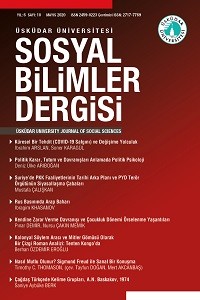Abstract
The incidence of self injurious behaviour which can be defined as the destruction of the body tissue by using methods that are not socially approved without the purpose of suicide, is increasing every day in the clinical and normal population. Studies on this subject suggest that there are many risk factors for self injurious behavior, such as psychodynamic factors, psychosocial factors, familial factors, biological factors and childhood abuse experiences. The purpose of this study is to review the studies dealing with self injurious behaviour and childhood abuse experiences, which are seen as risk factors for self ınjurious behaviour.
Keywords
Childhood Abuse Experiments Sexual Abuse Emotional Abuse Physical Abuse Neglect Self-Injurious Behavior
References
- Serafini, Gianluca. "The relationship between childhood maltreatment and non-suicidal self-injury: a systematic review." Frontiers in Psychiatry 8, sayı: 149 (2017).
- Turner, Sarah, Caitlin Menzies, Janique Fortier, Isabel Garces, Shannon Struck, Tamara Taillieu ve Tracey O. Afifi. "Child maltreatment and sleep problems among adolescents in Ontario: A cross sectional study." Child Abuse & Neglect (2020): 104-309
Abstract
Kişinin intihar amacı gütmeden sosyal olarak onaylanmayan metotlar kullanarak beden dokusunu tahrip etmesi olarak tanımlanan KZVD’nin klinik ve normal popülasyonda görülme sıklığı gün geçtikçe artmaktadır. Bu konuda yapılmış çalışmalar KZVD için psikodinamik etkenler, psikososyal etkenler, ailesel etkenler, biyolojik etkenler gibi birçok risk etkeni olduğunu öne sürmektedir. Çocukluk dönemi ihmal ve istismar yaşantılarını kapsayan çocukluk dönemi örselenme yaşantıları da bu risk etkenleri arasında yer almaktadır. Alanyazında, çocukluk döneminde örselenme deneyimlerine maruz kalmış olan bireylerin daha fazla KZVD gösterdiği belirtilmektedir. Bu çalışmanın amacı, kendine zarar verme davranışı ile KZVD için risk etkeni olarak görülen çocukluk dönemi örselenme yaşantılarını birlikte ele alan çalışmaların gözden geçirilmesidir
Keywords
örselenme yaşantıları kendine zarar verme davranışı duygusal istismar fiziksel istismar cinsel istismar ihmal
References
- Serafini, Gianluca. "The relationship between childhood maltreatment and non-suicidal self-injury: a systematic review." Frontiers in Psychiatry 8, sayı: 149 (2017).
- Turner, Sarah, Caitlin Menzies, Janique Fortier, Isabel Garces, Shannon Struck, Tamara Taillieu ve Tracey O. Afifi. "Child maltreatment and sleep problems among adolescents in Ontario: A cross sectional study." Child Abuse & Neglect (2020): 104-309
Details
| Primary Language | Turkish |
|---|---|
| Subjects | Psychology |
| Journal Section | Articles |
| Authors | |
| Publication Date | June 24, 2020 |
| Submission Date | April 4, 2020 |
| Published in Issue | Year 2020 Issue: 10 |
Cite
The opinions in the articles published in Üsküdar University Journal of Social Sciences belong to the author. The articles published in another journal, book, and so on are not accepted. National or international conference presentations, seminar presentations, or panel presentations can be included in the publication process after being specified in the footnote and converted into the article format.
Academic articles published in the journal can only be reproduced for educational purposes. The articles and the graphics and tables in the articles cannot be duplicated or archived in part or as a whole without permission except for educational purposes. Quotations may be made from the articles under the condition that they are indicated in the academic publications.
It is assumed that the authors undertake that they would not claim royalties for the articles they submit to Üsküdar University Journal of Social Sciences.


